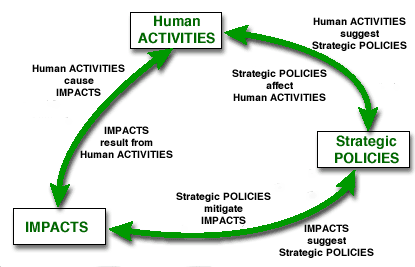| HUMAN ACTIVITIES |
IMPACTS/CAUSES |
STRATEGIES |
| RAPID URBAN GROWTH
• Rapid uncontrolled growth of urban areas, particularly low income. |
INSUFFICIENT LAND AND HOUSING SUPPLY
• Insufficient serviced land and shelter.
• Poorly functioning urban land and housing market
• Over-regulated prices
• Lack of affordable housing for poor. |
PROPERTY RIGHTS/MORTGAGES/ REGULATIONS
• Reform property rights
• Develop mortgage financing
• Introduce affordable standards and target subsidies to the poor
• Reduce unneeded regulations, government interventions and subsidies. |
| RAPID DEMAND FOR SERVICES
• Rapid increase of demand for services: water supply, sanitation, drainage, solid waste collection, and transport; both in quantity and quality |
INABILITY TO PROVIDE BASIC ENVIRONMENTAL INFRASTRUCTURE AND SERVICES
• Domination of supply by government monopoly
• Prices heavily regulated
• Heavy subsidies |
DEMAND MANAGEMENT/SUBSIDY REFORM/DECENTRALIZATION
• Introduce pricing and demand management
• Reduce subsidies
• Move toward decentralization, privatization, participation |
| UNCONTROLLED INDUSTRIAL EFFLUENT |
POLLUTED WATER AND ENVIRONMENT
• Uncontrolled municipal and industrial discharges
• Excessive water use and waste generation
• Failure to link water quantity and quality issues |
CHARGES/SUBSIDIES/
PLANNING
• Introduce water pricing and effluent charges
• Subsidize sewage treatment
Strengthen regulations and capacity for monitoring and enforcement
• Prepare comprehensive basic plans |
| INCREASED TRANSPORTATION AND ENERGY USE |
AIR POLLUTION
• Increased motorization and transport congestion
• Polluted ambient and indoor air
• Energy supply side dominated by government monopoly
• Heavy energy subsidies
• Household and cottage industry use of low-quality fuels |
PRICING STRATEGIES/
PLANNING/SUBSTITUTIONS
• Introduce energy and fuel pricing, road charges, emissions charges
• Reduce automobile subsidies, fuel subsidies
• Integrate transport and land use planning
• Promote clean technologies, fuel substitution, vehicle maintenance |
| INCREASE OF SOLID AND HAZARDOUS WASTE |
POLLUTION OF LAND AND AIR
• Poor municipal management
• Lack of disposal facilities
• Inadequate regulation and enforcement |
REGULATIONS/REDUCTION/
MANAGEMENT/PRIVATIZATION
• Introduce regulations, licensing and charges
• Simulate waste minimization
• Strengthen municipal management operations
• Privatize disposal operations |
| OVERUSE OF WATER |
GROUND WATER DEPLETION
• Unsustainable extraction linked to unclear property rights and treatment as free resource |
PROPERTY RIGHTS/CHARGES
• Clarify property rights
• Introduce extraction charges |
| SQUATTER DEVELOPMENT ON FRINGES OF URBAN AREAS |
LAND AND ECOSYSTEM DEGRADATION
• Low income settlements “pushed” onto fragile lands by lack of access to affordable serviced lands
• Lack of controls over damaging economic activities |
COORDINATE/REMOVE SHORTAGES/MONITOR AND ENFORCE
• Coordinate land development
• Remove artificial shortages of land
• Develop sustainable uses of sensitive areas
• Monitor and enforce land use controls |
| ENCROACHMENT AND DEVELOPMENT OF HISTORIC AREAS |
Loss of cultural and historic property
• Lack of property rights, regulations, enforcement, maintenance
• Failure to reflect social values in land prices |
INCENTIVES/REGULATIONS/
PROPERTY RIGHTS
• Introduce tax incentives for preservation
• Use redevelopment planning, zoning, and building codes
• Develop property rights |
| LACK OF CONSIDERATION FOR ENVIRONMENTAL HAZARDS IN DEVELOPMENT
Natural and man-made hazards |
HIGH-RISK AREAS WITH SEVERE AFFECTS FROM DISASTERS
• Poorly functioning land markets
• Ineffective land policies
• Poor construction practices
•Inadequate regulation and enforcement
• Low-income settlements alongside hazardous activities |
ENABLEMENT/DISINCENTIVES/
ENFORCEMENT/PREPAREDNESS
• Enable land markets
• Provide disincentives to occupation of high-risk areas, incentives for using disaster-resistant construction techniques
• Introduce and enforced environmental zoning
• Formulate urban disaster preparedness plans and strengthen response capacity |

